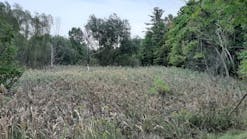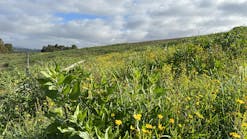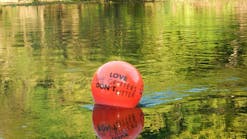Attempts to Create a Marshland
In one park-bordered area along the shoreline, erosion was cutting into a picnicking area, causing the 1-ft.-deep escarpment along the shoreline to continue to move inward each year. The first tried solution, Pierce says, was to place a 3-ft.-wide strip of riprap (8- to 16-in.-diameter stones) along the shoreline.Recalling the situation at Holmes Lake as it was in the early 1990s, Pierce says that the 400-ft.-long test section of riprap along the shoreline worked well, eliminating further erosion. Yet, he observes, environmentally conscious citizens often do not like this solution. It can be unsightly—not only the riprap itself but also the wild grasses (impossible to mow) growing up through it—and restricts people’s access to the lake because it is difficult to walk on, especially with bare feet. Riprap can also damage canoes and other boats that are dragged over it into and out of the water. It significantly reduces animal habitat along the shoreline, although in areas above the water line, vegetation often grows up through the riprap (in the riprap wet zone, water often washes out newly placed plant seeds, and wave action beats down seedlings).In 1990, Pierce was part of a group headed by the Army Corps of Engineers that attempted to find an alternative to the traditional riprap approach to shoreline protection. The aim was to find a natural way to prevent shoreline erosion around Holmes Lake by establishing a natural marsh along a 300-ft.-long test section of shoreline. This test section had a 3-ft.-high escarpment that had already been gouged out by wave action. The plan to establish a natural marsh involved these steps:Establish a 10-ft.-wide no-mow strip along the top of the escarpment for the entire 300 ft. The roots of the grasses and other plantings here, the planners believed, would help stabilize the land side of the escarpment against further erosion.Establish on the lake side of the escarpment a 10-ft.-wide zone for growing wetland grasses. This zone, which is alternately submerged in shallow water (less than 18 in.) or dry (depending on time of year), would likewise extend for the full 300-ft.-long test section.The wetland grasses planted here—sedges (with leafless stems typically 6 ft. high); spike rushes (with leafless stems typically a few inches high, establishing a grasslike carpet of vegetation); and river bulrushes (with leafy stems typically 4 ft. high) – were gathered from a shoreline site along the Missouri River about 70 mi. away because the planners could not get permission to collect grasses from any suitable wetlands closer to Lincoln. Why these particular wetland plantings? As Pierce explains it, the Holmes Lake planning group wanted to form in the shallow water near the shoreline a dense cover of stems and leaves to break the energy of the water’s waves and thus greatly reduce further erosion of the shoreline escarpment—to create what he calls “a living breakwater to break the water’s energy.” The stems and blades of these marsh grasses provide frictional resistance to incoming waves, thereby dissipating wave energy before it reaches the shoreline. Water depths must be under 18 in. for these aquatic plants to survive.Such wave-energy dissipation could best be achieved, Pierce believed, by planting a mix of short and tall grasses. Further, these sedges and rushes have dense rhizomes; that is, they form a dense network of horizontal roots beneath the ground surface that holds the soil in place. As for the 10-ft.-wide no-mow zone on the land side of the escarpment, the planners hoped that by not mowing the planted and native grasses to be established there, their roots would grow deeper and denser, retarding further collapse of the escarpment.Riding ring part of the park in November 1967Marshland Nemesis: Canada Geese
The planning group encountered a major problem, however, when first attempting to plant the marsh area: the presence of nonmigratory Canada geese. These geese, found in many areas of the US, constitute a severe obstacle in trying to establish new marshes because they eat the tops off newly growing plants and even pull them out of the soil. (Ducks and carp also feed on new plantings but to a lesser extent.) The geese are less of a problem in well-established wetlands, which usually do not have the long, clear openings geese need to land and take off.In an attempt to prevent the geese from continuing with such destructive activity, the Army Corps of Engineers first laid down chicken wire on the surface of the ground where the new plants were growing, hoping that the geese would be reluctant to walk on it. This hope was quickly dashed. Although hesitant at first, the geese quickly adapted and before long were walking on the wire, once again devouring the infant plants.The next measure to deal with the geese proved very effective. Realizing that geese are rather ungainly creatures requiring considerably clear areas in which to land and take off, the corps constructed a simple string fence to break up the 10-ft.-wide x 300-ft.-long test marsh area. The fence consisted of 3-ft.-high wooden stakes driven into the ground every 20 ft. Cotton string spanned the distance between adjacent posts; three lines of string were used, each fastened at a different height on the fence posts.Overall the fence was 300 ft. long, running along a line 10 ft. out in the water and parallel to the shoreline escarpment. Every 30 ft. a string ran perpendicularly from this main fence to the shoreline escarpment. These transverse fences served to break up the test planting area, preventing the geese—which fly, Pierce explains, more like a Boeing 747 than a helicopter—from landing and taking off. In sum, he says, these simple, inexpensive string fences kept the Canada geese out of the newly planted marshland, enabling the plants to get established. Pierce believes that the planners at Holmes Lake were among the first in the US to use this technique. Until that time, Canada geese had been a major obstacle to planting new marshlands for shoreline protection not only at Holmes Lake but in many other areas of the US.
This test marshland at Holmes Lake was planted in the summer of 1990. According to Pierce, the newly planted marsh vegetation grew well, formed a mature marsh, and reduced the erosion of the shoreline escarpment to only 5–10% of what it had been. Opting for Spalls and Riprap
After the mid-1990s, however, the marshland approach to protecting the shoreline of Holmes Lake was largely abandoned. The string fence was removed, and the geese returned to eat many of the marshland grasses. To protect the escarpment from further erosion, the Lincoln Parks and Recreation Department placed riprap at its base. The only remnants of the original marshland were a few grasses growing through the riprap.
Economic and social factors contributed to the change. The Parks and Recreation Department, which maintains Holmes Lake and surrounding parklands, took a different view on the issue of engineered versus natural solutions to lakeshore protection. For an urban lake such as Holmes Lake—5 mi. southeast of downtown Lincoln—the department favored using small rocks (spalls) to protect against shoreline erosion instead of trying to establish natural marshes.Beach scene from June 1970Sail boating in 1967Over a period of several years, the Army Corps of Engineers and the Parks and Recreation Department moved to protect the shoreline of Holmes Lake in the areas of most severe erosion by installing a protective blanket of spalls (4- to 5-in.-diameter rock) along the shoreline. (Because prevailing winds come from the southeast, wave action and erosion are greatest on the northwest and north shorelines.) The rock is too small to be called riprap but too large for children to throw into the lake. Typically the spall blanket running along the shoreline is 10 ft. wide and 6–8 in. thick. The water line is almost always on this blanket, never below or above it. In areas where there was an escarpment, it has been leveled off with the spalls so that the escarpment is no longer visible.As Bob Willcuts of the corps’ Omaha District in Lincoln points out, no filter fabric was placed on the ground before laying down the spall blanket. Although it is possible for some soil to wash out from underneath the stones as a result of wave action, the situation is not critical. Using filter fabric can add substantially to the cost of a project. Consequently the corps tends to use its three-layered solution of sand filter (or filter fabric), spalls, and riprap only in structurally critical situations, such as on a levee or on the upstream face of an earthen dam.In most cases of protecting reservoir shorelines from erosion, Willcuts points out, the corps lays down a blanket of spalls with a layer of riprap on top. Why the need for the riprap? Willcuts explains that the extra layer is usually needed to provide protection against wave action and to prevent the smaller 4- to 5-in.-diameter stones comprising the spall blanket from eventually washing back into the lake. Willcuts believes the riprap layer was omitted at Holmes Lake because it is an urban lake used by many people and the riprap would have made access to the water more difficult. Yet there is a risk that much of the spall blanket at Holmes Lake will eventually get washed into the lake. Actually, Willcuts says, in most reservoir shoreline protection installations, the corps installs one pass of graded riprap—a mixture of small, medium, and large rocks. It would add substantially to the cost to first lay the small rock, then the medium, and so on.According to Willcuts, the grayish-white spalls for Homes Lake came from a limestone quarry about 50 mi. from Lincoln. The cost was $8.00–$8.50/ton, but delivery to the Holmes Lake construction site increased that to a total delivered cost of about $16/ton. If a quarry is more than 50 mi. from the construction site, transportation costs can far exceed the cost of the rock itself. The placement cost is typically $100/hr. for one man and his front-end loader. After the changes, the Parks and Recreation Department was able to mow the grass of the surrounding parkland right up to the spall blanket, important in giving this recreational complex a manicured look. The spalls on the lower part of the blanket became covered with sediment, which recreational fishermen welcome because they do not like walking on the spalls.Although the department did not object in general to using the marshland approach to control shoreline erosion, some planners believe it is more suitably applied to lakes in rural settings—not to urban lakes such as Holmes. Thousands of people drive by this urban lake daily, so aesthetics is very important. The high grasses of the natural marshland obstruct the view of the lake and have an unkempt, unmanicured look, but the spalls provide a much cleaner look. As the earlier Holmes Lake experience shows, new marshlands require considerable maintenance and protection until they become established, but even when the grasses are well established, they can be adversely affected by drought and heat. And wave action can still continue to cause some erosion. In addition, mature marshlands attract species, such as geese, that can be a real nuisance to recreational users of the lake-park complex—devouring the blue grasses on adjacent golf courses and baseball fields and leaving their droppings along concrete walkways and bike paths, picnic tables, and the marina. As a department employee notes, “One thousand geese can devour a ball field overnight.” At one point, the department became home for a specially trained Border Collie named Shep, whose major task was to stand guard and chase away geese from park areas. Further, as the corps’ Willcuts points out, Canada geese often foul the lake water with their droppings, resulting in rising coliform levels and the closing of lake waters to swimming. To prevent the spall blanket from hindering recreational users’ access to the lake, the Parks and Recreation Department provided special access areas. For example, during the summer, the city cleared a 12-ft.-wide path through the spall blanket to enable people to pull their jet skis over a muddy ground rather than over spalls. To spare winter ice skaters the agony of walking on a spall blanket with skates on, the department constructed iron steps coated with a rubber surface, over which skaters can readily walk to the lake.





